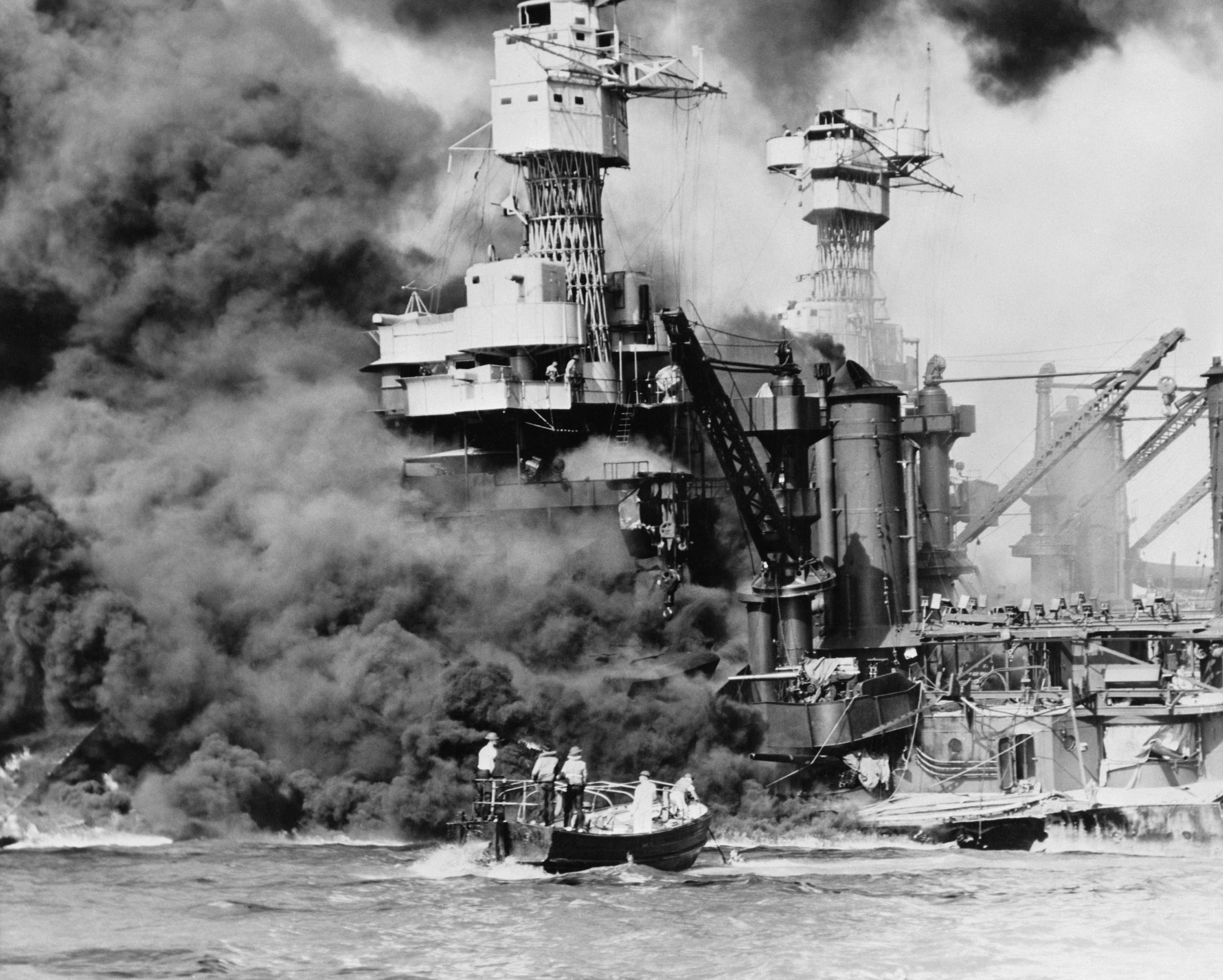 On Sunday, 7 December 1941, West Virginia lay moored outboard of Tennessee at berth F-6 with 40 ft (12 m) of water beneath her keel. Shortly before 0800, Japanese planes, flying from a six-carrier task force, commenced a well-planned attack on Pearl Harbor. Several 18 in (460 mm) aerial torpedoes impacted the port side of West Virginia. One torpedo hit the steering gear and knocked off the rudder. At least three struck below the armor belt, and one or more struck the armor belt requiring replacement of seven armor plates. One or possibly two torpedoes entered the ship through holes made by the first torpedoes while the ship was listing and exploded on the armored second deck. Recent evidence indicates that at least one of the hits may have come from a midget submarine. Photographic analysis performed by the United States Naval Institute in 1999 may indicate that one Japanese midget submarine managed to enter the harbor and fired a torpedo into West Virginia. The final disposition of this submarine is unknown.
On Sunday, 7 December 1941, West Virginia lay moored outboard of Tennessee at berth F-6 with 40 ft (12 m) of water beneath her keel. Shortly before 0800, Japanese planes, flying from a six-carrier task force, commenced a well-planned attack on Pearl Harbor. Several 18 in (460 mm) aerial torpedoes impacted the port side of West Virginia. One torpedo hit the steering gear and knocked off the rudder. At least three struck below the armor belt, and one or more struck the armor belt requiring replacement of seven armor plates. One or possibly two torpedoes entered the ship through holes made by the first torpedoes while the ship was listing and exploded on the armored second deck. Recent evidence indicates that at least one of the hits may have come from a midget submarine. Photographic analysis performed by the United States Naval Institute in 1999 may indicate that one Japanese midget submarine managed to enter the harbor and fired a torpedo into West Virginia. The final disposition of this submarine is unknown.West Virginia was also hit by two bombs made from 16 in (410 mm) armor-piercing shells fitted with fins. The first bomb hit the foretop, penetrated the superstructure deck, and was found unexploded in the debris on the second deck. The second bomb hit further aft, wrecking one Vought OS2U Kingfisher floatplane atop the "high" catapult on Turret III and pitching the second one on her top on the main deck below. The projectile penetrated the 4 in (100 mm) turret roof, wrecking one gun in the turret itself. Although the bomb was another dud, burning gasoline from the damaged aircraft caused some damage. West Virginia was then seriously damaged by being engulfed in an oil fire started by Arizona and sustained for 30 hours by fuel leaking from both ships.
The torpedoes caused two large holes extending from Frames 43 to 52 and from Frames 62 to 97. Prompt action by Lieutenant Claude V. Ricketts (Claude V. Ricketts later had a ship named after him, the USS Claude V. Ricketts (DDG-5), formerly the USS Biddle), the assistant fire control officer who had some knowledge of damage control techniques, saved the ship from the fate that befell Oklahoma moored ahead. Oklahoma also took several torpedo hits that, in her case, flooded the ship and caused her to capsize.
Instances of heroic conduct onboard the heavily damaged battleship proliferated in the heat of battle. The ship's commanding officer, Captain Mervyn S. Bennion, arrived on his bridge early in the battle, only to be struck down by a bomb fragment hurled in his direction when a 16 in (410 mm) bomb hit the center gun in Tennessee's Turret II, spraying that ship's superstructure and West Virginia's with fragments. Bennion, hit in the abdomen, crumpled to the deck, mortally wounded, but clung tenaciously to life until just before the ship was abandoned, involved in the conduct of the ship's defense up to the last moment of his life. For his "conspicuous devotion to duty, extraordinary courage, and complete disregard of his own life", Captain Bennion was awarded the Medal of Honor, posthumously. Doris Miller, a cook, helped carry Captain Bennion to a safer place and then manned an antiaircraft gun despite having no previous experience. He was the first African-American recipient of the Navy Cross.
West Virginia was abandoned, settling to the harbor bottom on an even keel, her fires fought from on board by a party that volunteered to return to the ship after the first abandonment. By the afternoon of the following day, 8 December, the flames had been extinguished. The garbage lighter YG-17 played an important role in assisting those efforts during the Pearl Harbor attack, remaining in position alongside despite the danger posed by exploding ammunition on board the battleship. With a patch over the damaged area of her hull, the battleship was pumped out and ultimately refloated on 17 May 1942 and docked in Drydock Number One on 9 June. This gave the opportunity for a more detailed damage assessment and it became clear that there had been not six, but seven torpedo hits.
During the ensuing repairs, workers located 66 bodies of West Virginia sailors who had been trapped below when the ship sank. Several bodies were found lying on top of steam pipes within the air bubble existing in flooded areas. Three bodies were found in a store room compartment where they had lived on emergency rations and fresh water from a battle station. A calendar found with them indicated they had lived through 23 December. The task confronting the nucleus crew and shipyard workers was a monumental one, so great was the damage on the battleship's port side. Ultimately, however, West Virginia departed Pearl Harbor for the west coast and a complete rebuilding at the Puget Sound Navy Yard at Bremerton, Washington.

No comments:
Post a Comment